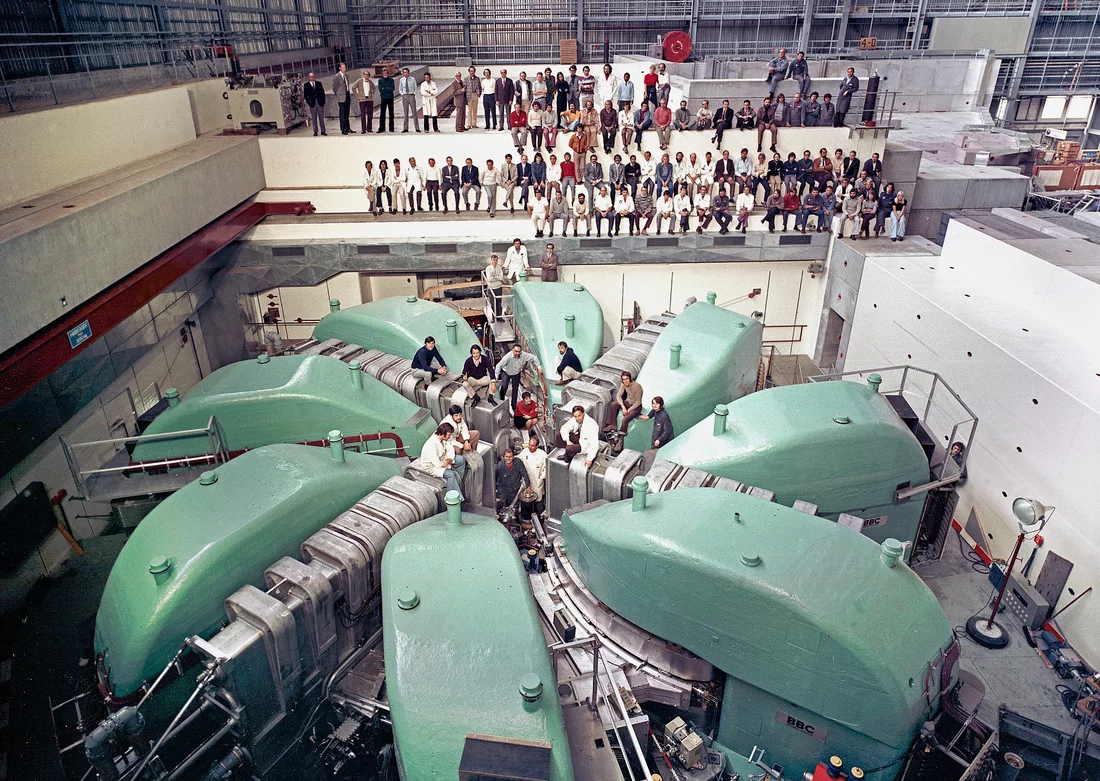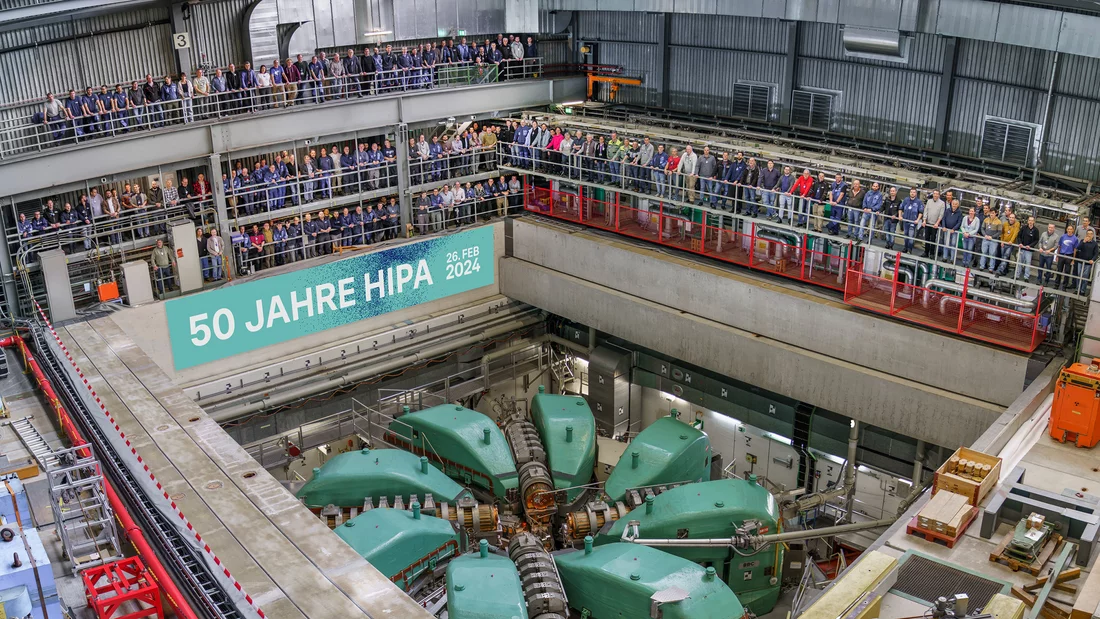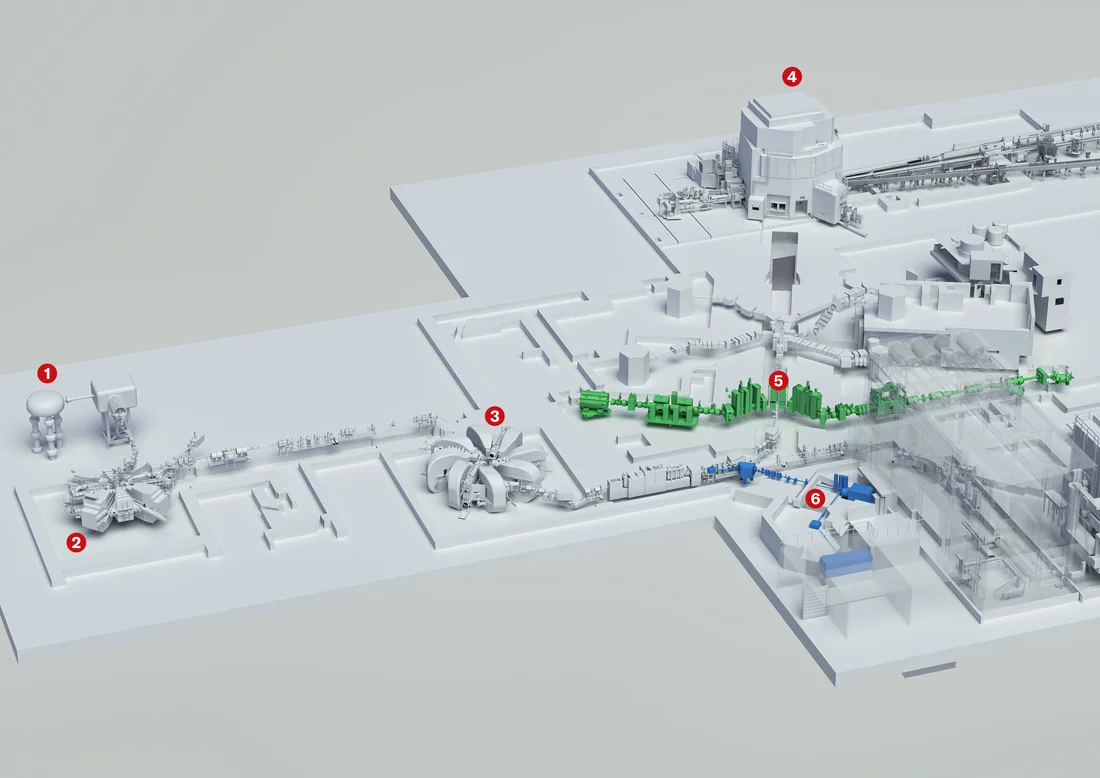The proton accelerator facility HIPA at PSI has half a century under its belt and has never been more powerful than today: It delivers 1.4 million watts for research. A journey through the past 50 years – and a look into the future.
It was just last year that PSI celebrated its 35th anniversary, and now, in February 2024, PSI’s proton accelerator is already 50 years old. The facility that we know today as HIPA was called the SIN Facility when it went into operation in 1974, because it belonged to the Swiss Institute for Nuclear Research SIN. The facility itself was not moved; rather, PSI was more or less created around it in 1988, as a merger of SIN west of the Aare and the Federal Institute for Reactor Research EIR east of the river. The SIN Facility became HIPA: the High-Intensity Proton Accelerator.
The name also describes retrospectively the full 50 years of the facility. Protons were extracted here for the first time in January 1974. A success, nevertheless not the main goal, because the protons themselves were hardly ever used here. The idea formulated when the facility was planned in 1962 was a «meson factory»: The accelerated protons would be used to mass-produce mesons, a certain class of subatomic particles.
Mesons arise naturally in the upper layers of the earth’s atmosphere. Or they are produced by human effort, as has been the case for 50 years thanks to HIPA. Specifically, this requires so-called targets: special workpieces made of graphite onto which the proton beam is directed, whereby mesons are produced in the material.
50 years of the meson factory
And in fact: The first protons were followed by the first mesons around one month later – at the end of February 1974, the time had come. In keeping with the spirit of the meson factory, this is the occasion that has been celebrated in anniversaries ever since.
The mesons from factory production hold the world record today: Nowhere else in the world are so many muons – a type of particle that can occur from mesons – produced per second for research. They are used at numerous experiment stations around HIPA. On the one hand, for example, they are used by researchers in particle physics to measure protons and atomic nuclei. In materials science, on the other hand, muons serve as tiny probes that penetrate solids and thus measure their internal structure and properties.
The main thing that has changed over the past decades is the number of protons – and with them, muons and other secondary particles – that the facility produces per second. The proton rate is measured in amperes, the unit of current, since protons have a positive electric charge. The facility has already reached 2.4 milliamperes. The number may seem small, because the elementary charge of a proton is small – but in fact it represents more than ten quadrillion protons per second, which is a 1 followed by 16 zeroes. This proton beam has a power of 1.4 million watts.
It started out much more modestly: 0.1 milliamperes was the original target of the facility when it went into operation in 1974. It took less than three years for this value to be reached, in December 1976. «From then on it was clear that the facility could do significantly more,» says Joachim Grillenberger, a physicist at PSI for 20 years and today head of the Proton Facilities group. He calls the facility «an outstanding legacy of the builders.»
1962: idea for a Swiss «meson factory»
1974: commissioning of the SIN Facility (later HIPA)
1976: original target of 0.1 milliamperes achieved
1985: Injector 2 takes over the role of the previous Injector 1
1988: founding of PSI as merger of EIR und SIN
1996: commissioning of the neutron source SINQ
2011: commissioning of the UCN source
Planned from 2025: upgrade project IMPACT
And so the system continued, with renewals and upgrades, gradually increasing the proton current. In 1985 the new pre-accelerator Injector 2 was put into operation, and since then it has provided the middle of the three acceleration levels for the protons. With this the proton rate climbed into ranges that were interesting for the production of another kind of secondary particle: neutrons. That required a target made of lead in the centre of a completely new large research facility: The neutron source SINQ was built. Since 1996, it has been generating neutrons for the study of quantum materials, for the non-destructive investigation of archaeological artifacts, and for the quality assurance of components for the aerospace industry, among other things.
In 2011 the somewhat smaller, but quite special, ultracold neutron source UCN was added – it too is fed on the protons from HIPA and likewise enables particle physics, specifically investigations into the fundamental properties of the neutron.
«HIPA is really an outstanding machine,» says Alex Amato, interim head of the Research with Neutrons and Muons Division. «PSI is known for its large research facilities, which are used not only by us, but also by guest researchers.» These come from Switzerland and abroad, and from the academic world as well as industry. PSI racked up around 40,500 such visits between 2014 and 2023. «At present, around half of all guest researchers come to us at PSI for experiments involving the HIPA proton accelerator. And what makes us especially happy is that they come from fundamental physics, archaeology, botany, mechanical engineering, and many other quite different disciplines and fields of study.»
More mesons and radionuclides for the future
Amato sees the 50th anniversary celebration as an opportunity to look not only back on the facility’s past, but also into its future. The evolution of HIPA is by no means at an end. The next upgrade is already in the starting blocks. It carries the name IMPACT: Isotope and Muon Production with Advanced Cyclotron and Target Technologies.
On the one hand, IMPACT carries the history of the meson factory forwards: By replacing one of the two graphite targets and the associated target environment, the number of muons available per second will increase by a factor of 100 in the future, to ten billion muons per second. This will benefit particle physics as well as materials science, enable significantly more precise experiments than before, and further push the global limits of what it is possible to investigate.
In addition, the second part of the IMPACT project will set up a completely new facility at HIPA, where radionuclides for targeted cancer diagnostics and therapy are to be produced. Here the protons will be used to create and extract medically relevant isotopes. The researchers want to produce and investigate many different types of radionuclides, and to do this in larger quantities than heretofore possible. The University of Zurich and the University Hospital of Zurich are taking part in the project.
«With the planned upgrade IMPACT, we will remain at the forefront of the current scientific questions and will keep research at HIPA on the top level, for the coming decades as in the past,» says Daniela Kiselev, department head of Accelerator Operation and Development at PSI and leader of the project management team for IMPACT. «We will be able to investigate novel materials for the technologies of the future even more precisely than before. We will be able to continue improving a long-term experiment that is searching for a specific particle decay and is helping to explore the limits of the so-called standard model of particle physics. Last but not least, with the radionuclides we are also bringing the fight against cancer to our high-energy facility.»
The upgrade IMPACT is planned for the Swiss research funding period beginning in 2025. It has already been included in the Swiss Roadmap for Research Infrastructures. At the end of 2024, the Swiss parliament will decide on the upcoming ERI Dispatch and thus on the financing of IMPACT.
Text: Paul Scherrer Institute/Laura Hennemann
© PSI provides image and/or video material free of charge for media coverage of the content of the above text. Use of this material for other purposes is not permitted. This also includes the transfer of the image and video material into databases as well as sale by third parties.



